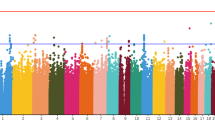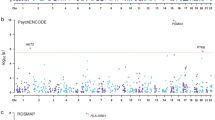Abstract
The aim of this study was to investigate the association of drug-metabolizing enzyme and transporter (DMET) polymorphisms with the risperidone-induced prolactin response using an overlapping gene model between serum prolactin level and hyperprolactinemia in autism spectrum disorder (ASD) patients. Eighty-four ASD patients who were receiving risperidone for at least 1 month were recruited and then assigned to either the normal prolactin group or the hyperprolactinemia group based on their serum prolactin level. The genotype profile of 1936 (1931 single nucleotide polymorphisms (SNPs) and 5 copy number variation (CNVs) drug metabolism markers was obtained using the Affymetrix DMET Plus GeneChip microarray platform. Genotypes of SNPs used to test the accuracy of DMET genotype profiling were determined using TaqMan SNP Genotyping Assay kits. Eighty-four patients were selected for the allelic association study after microarray analyses (51 in the normal prolactin group, and 33 in the hyperprolactinemia group). An overlapping allelic association analysis of both analyses discovered five DMET SNPs with a suggestive association (P < 0.05) with risperidone-induced prolactin response. Three UGT1A1 SNPs (UGT1A1*80c.-364C > T, UGT1A1*93 c.-3156G > A, and UGT1A1 c.-2950A > G, showed a suggestive association with the risperidone-induced prolactin response and found to be in complete linkage disequilibrium (D′ value of 1). In this DMET microarray platform, we found three UGT1A1 variants with suggestive evidences of association with the risperidone-induced prolactin response both measured by hyperprolactinemia and by prolactin level. However, due to the lack of validation studies confirmation and further exploration are needed in future pharmacogenomic studies.
This is a preview of subscription content, access via your institution
Access options
Subscribe to this journal
Receive 6 print issues and online access
$259.00 per year
only $43.17 per issue
Buy this article
- Purchase on Springer Link
- Instant access to full article PDF
Prices may be subject to local taxes which are calculated during checkout



Similar content being viewed by others
References
Bethea TC, Sikich L. Early pharmacological treatment of autism: a rationale for developmental treatment. Biol Psychiatry. 2007;61:521–37.
Parikh MS, Kolevzon A, Hollander E. Psychopharmacology of aggression in children and adolescents with autism: a critical review of efficacy and tolerability. J Child Adolesc Psychopharmacol. 2008;18:157–78.
Haas M, Karcher K, Pandina GJ. Treating disruptive behavior disorders with risperidone: a 1-year, open-label safety study in children and adolescents. J Child Adolesc Psychopharmacol. 2008;18:337–45.
Levine SZ, Kodesh A, Goldberg Y, Reichenberg A, Furukawa TA, Kolevzon A, et al. Initial severity and efficacy of risperidone in autism: Results from the RUPP trial. Eur Psychiatry. 2016;32:16–20.
Pandina GJ, Bossie CA, Youssef E, Zhu Y, Dunbar F. Risperidone improves behavioral symptoms in children with autism in a randomized, double-blind, placebo-controlled trial. J Autism Dev Disord. 2007;37:367–73.
Anderson GM, Scahill L, McCracken JT, McDougle CJ, Aman MG, Tierney E, et al. Effects of short- and long-term risperidone treatment on prolactin levels in children with autism. Biol Psychiatry. 2007;61:545–50.
Hongkaew Y, Ngamsamut N, Puangpetch A, Vanwong N, Srisawasdi P, Chamnanphon M, et al. Hyperprolactinemia in Thai children and adolescents with autism spectrum disorder treated with risperidone. Neuropsychiatr Dis Treat. 2015;11:191–6.
Ngamsamut N, Hongkaew Y, Vanwong N, Srisawasdi P, Puangpetch A, Chamkrachangpada B, et al. 9-Hydroxyrisperidone-induced hyperprolactinaemia in thai children and adolescents with autism spectrum disorder. Basic Clin Pharmacol Toxicol. 2016;119:267–72.
Roke Y, van Harten PN, Buitelaar JK, Tenback DE, de Rijke YB, Boot AM. Antipsychotic-induced hyperprolactinemia and testosterone levels in boys. Horm Res Paediatr. 2012;77:235–40.
dos Santos Junior A, Henriques TB, de Mello MP, Ferreira Neto AP, Paes LA, Della Torre OH, et al. Hyperprolactinemia in children and adolescents with use of risperidone: clinical and molecular genetics aspects. J Child Adolesc Psychopharmacol. 2015;25:738–48.
Correia CT, Almeida JP, Santos PE, Sequeira AF, Marques CE, Miguel TS, et al. Pharmacogenetics of risperidone therapy in autism: association analysis of eight candidate genes with drug efficacy and adverse drug reactions. Pharm J. 2010;10:418–30.
Yoo HD, Cho HY, Lee SN, Yoon H, Lee YB. Population pharmacokinetic analysis of risperidone and 9-hydroxyrisperidone with genetic polymorphisms of CYP2D6 and ABCB1. J Pharmacokinet Pharmacodyn. 2012;39:329–41.
Vandenberghe F, Guidi M, Choong E, von Gunten A, Conus P, Csajka C, et al. Genetics-based population pharmacokinetics and pharmacodynamics of risperidone in a psychiatric cohort. Clin Pharmacokinet. 2015;54:1259–72.
Thyssen A, Vermeulen A, Fuseau E, Fabre MA, Mannaert E. Population pharmacokinetics of oral risperidone in children, adolescents and adults with psychiatric disorders. Clin Pharmacokinet. 2010;49:465–78.
Yoo HD, Lee SN, Kang HA, Cho HY, Lee IK, Lee YB. Influence of ABCB1 genetic polymorphisms on the pharmacokinetics of risperidone in healthy subjects with CYP2D6*10/*10. Br J Pharmacol. 2011;164:433–43.
Ahmed S, Zhou Z, Zhou J, Chen SQ. Pharmacogenomics of drug metabolizing enzymes and transporters: relevance to precision medicine. Genomics Proteomics Bioinformatics. 2016;14:298–313.
Puangpetch A, Vanwong N, Nuntamool N, Hongkaew Y, Chamnanphon M, Sukasem C. CYP2D6 polymorphisms and their influence on risperidone treatment. Pharmgenomics Pers Med. 2016;9:131–47.
Sukasem C, Hongkaew Y, Ngamsamut N, Puangpetch A, Vanwong N, Chamnanphon M, et al. Impact of pharmacogenetic markers of CYP2D6 and DRD2 on prolactin response in risperidone-treated thai children and adolescents with autism spectrum disorders. J Clin Psychopharmacol. 2016;36:141–6.
Wakil SM, Nguyen C, Muiya NP, Andres E, Lykowska-Tarnowska A, Baz B, et al. The affymetrix DMET plus platform reveals unique distribution of ADME-related variants in ethnic Arabs. Dis Markers. 2015;2015:542543.
Arbitrio M, Di Martino MT, Scionti F, Agapito G, Guzzi PH, Cannataro M, et al. DMET (Drug Metabolism Enzymes and Transporters): a pharmacogenomic platform for precision medicine. Oncotarget. 2016;7:54028–50.
Scott LJ, Dhillon S. Risperidone: a review of its use in the treatment of irritability associated with autistic disorder in children and adolescents. Paediatr Drugs. 2007;9:343–54.
Elmlinger MW, Kuhnel W, Ranke MB. Reference ranges for serum concentrations of lutropin (LH), follitropin (FSH), estradiol (E2), prolactin, progesterone, sex hormone-binding globulin (SHBG), dehydroepiandrosterone sulfate (DHEAS), cortisol and ferritin in neonates, children and young adults. Clin Chem Lab Med. 2002;40:1151–60.
Fernandez Zapico ME, Ahmad US, Urrutia R. DNA microarrays: revolutionary insight into the living genome. Surgery. 2001;130:403–7.
Burmester JK, Sedova M, Shapero MH, Mansfield E. DMET microarray technology for pharmacogenomics-based personalized medicine. Methods Mol Biol. 2010;632:99–124.
Hu Y, Ehli EA, Nelson K, Bohlen K, Lynch C, Huizenga P, et al. Genotyping performance between saliva and blood-derived genomic DNAs on the DMET array: a comparison. PloS One. 2012;7:e33968.
Barrett JC, Fry B, Maller J, Daly MJ. Haploview: analysis and visualization of LD and haplotype maps. Bioinformatics. 2005;21:263–5.
Maurer A, Sannemann W, Leon J, Pillen K. Estimating parent-specific QTL effects through cumulating linked identity-by-state SNP effects in multiparental populations. Heredity (Edinb). 2017;118:477–85.
Hartshorne T. TaqMan(R) drug metabolism genotyping assays for the detection of human polymorphisms involved in drug metabolism. Methods Mol Biol. 2013;1015:87–96.
Fernandez CA, Smith C, Yang W, Lorier R, Crews KR, Kornegay N, et al. Concordance of DMET plus genotyping results with those of orthogonal genotyping methods. Clin Pharmacol Ther. 2012;92:360–5.
Marques SC, Ikediobi ON. The clinical application of UGT1A1 pharmacogenetic testing: gene-environment interactions. Hum Genomics. 2010;4:238–49.
de Leon J. Glucuronidation enzymes, genes and psychiatry. Int J Neuropsychopharmacol. 2003;6:57–72.
Álamo C, López-Muñoz F. The pharmacological role and clinical applications of antipsychotics’ active metabolites: paliperidone versus risperidone. Clin Exp Pharmacol. 2013;3:117.
English BA, Dortch M, Ereshefsky L, Jhee S. Clinically significant psychotropic drug-drug interactions in the primary care setting. Curr Psychiatry Rep. 2012;14:376–90.
Lu M-L, Lane H-Y. Clinically significant interactions with antipsychotics. In: Jann MW, Penzak SR, Cohen LJ, editors.. Applied clinical pharmacokinetics and pharmacodynamics of psychopharmacological agents. Cham: Springer International Publishing; 2016. p. 397–421.
Ivanova SA, Osmanova DZ, Freidin MB, Fedorenko OY, Boiko AS, Pozhidaev IV, et al. Identification of 5-hydroxytryptamine receptor gene polymorphisms modulating hyperprolactinaemia in antipsychotic drug-treated patients with schizophrenia. World J Biol Psychiatry. 2017;18:239–46.
Calarge CA, Ellingrod VL, Acion L, Miller DD, Moline J, Tansey MJ, et al. Variants of the dopamine D2 receptor gene and risperidone-induced hyperprolactinemia in children and adolescents. Pharmacogenet. Genomics. 2009;19:373–82.
Sim SC, Kacevska M, Ingelman-Sundberg M. Pharmacogenomics of drug-metabolizing enzymes: a recent update on clinical implications and endogenous effects. Pharmacogenomics J. 2013;13:1–11.
Murphy GM Jr.. Application of microarray technology in psychotropic drug trials. J Psychopharmacol. 2006;20:72–8.
Acknowledgements
Financial support from the Thailand Research Fund through the Royal Golden Jubilee Ph.D. Program (Grant No. PHD/0107/2557) to Yaowaluck Hongkaew and Chonlaphat Sukasem is acknowledged. We thank all the staff in Yuwaprasart Waithayopathum Child and Adolescent Psychiatric Hospital and all the children and adolescents with ASD who participated in the study.
Funding
This study was supported by grants of the (1) the Thailand Research Fund through the Royal Golden Jubilee Ph.D. Program (Grant No. PHD/0107/2557), (2) Pharmacogenomics for Autistic Child Project, Khoon Poom Foundation, The Project of Her Royal Highness Princess Ubonratana Rajakanya Siriwatana Bhanawadee, (3) Office of National Research Council of Thailand, (4) Faculty of Medicine Ramathibodi Hospital, and (5) Mahidol University.
Author information
Authors and Affiliations
Corresponding author
Ethics declarations
Conflict of interest
The authors declare that they have no conflict of interest.
Electronic supplementary material
Rights and permissions
About this article
Cite this article
Hongkaew, Y., Medhasi, S., Pasomsub, E. et al. UGT1A1 polymorphisms associated with prolactin response in risperidone-treated children and adolescents with autism spectrum disorder. Pharmacogenomics J 18, 740–748 (2018). https://doi.org/10.1038/s41397-018-0031-7
Received:
Revised:
Accepted:
Published:
Issue Date:
DOI: https://doi.org/10.1038/s41397-018-0031-7
This article is cited by
-
Genetic Analysis of UGT1A1 Polymorphisms Using Preserved Dried Umbilical Cord for Assessing the Potential of Neonatal Jaundice as a Risk Factor for Autism Spectrum Disorder in Children
Journal of Autism and Developmental Disorders (2022)



